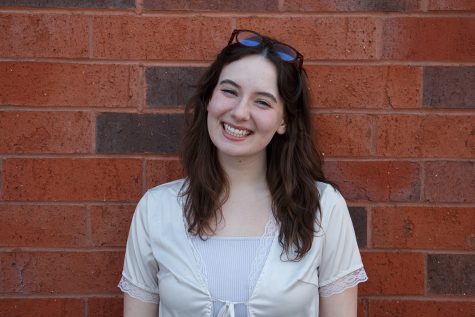Upcoming Blugold Dialogue on studio arts
Student-faculty research team to present on implementing EDI into Studio Arts Education at upcoming OMA event
Photo by Submitted by Kenz Mevis
“If students speak up, the chances for change — a healthy and productive change that builds bridges — can happen on this campus,” Marie said.
“A healthy community is a diverse one,” Cedar Marie, assistant professor of arts, said. “If you want to be in a healthy community, then you need to have, at some level, acceptance and empathy — an open mind and heart — and be able to listen.”
On April 7, the Office of Multicultural Affairs will be hosting a Blugold Dialogue. Marie and Mackenzie Mevis, a fifth-year art education student, will present the research they have been conducting.
Their presentation is titled “Implementing EDI into Studio Arts Education” and looks into how to incorporate equity, diversity, and inclusivity into course curriculums.
“We looked at the curriculum that was in place for the 100 level 3-D Design course,” Mevis said. “We picked apart the rubric for each project and looked into how we could incorporate EDI into each of them.”
Their objective was not to restructure the curriculum itself, necessarily, but to incorporate EDI as they went, Mevis said.
“This presentation we’re doing is showing others how we went about this process and to hopefully show that this is something you can do in any content area,” Mevis said. “You can examine what you already have and find ways to make it more equitable.”
As advocacy for EDI grows in light of recent events, such as the Black Lives Matter movement resurgence in the summer of 2020 and with the current rise in violence against the Asian American and Pacific Islander community, the issue is made even more important, Mevis said.
“It felt very natural,” Mevis said. “Throughout our research, we continually asked ourselves what we could do to be better, and what can we do to better serve every student who walks through that door, regardless of their background.”
OMA reached out to Marie and Mevis because of these key EDI elements, Marie said.
“For us it was creating these projects that provided students with opportunities to research more about cultures outside theirs while still creating sculptures and learning about 3-D art,” Marie said.
They hope to inspire other departments to re-examine their curriculum, Mevis said.
Part of their mission was ensuring the implementation of EDI didn’t come off as superficial, they said. To combat this, they dove into learning about contemporary artists of color and art history, the latter often falling victim to whitewashing.
“There are so many BIPOC artists, both throughout history and in the contemporary world of art, that we should be intentional about talking about,” Mevis said. “Not only to represent those students but to show that there are BIPOC artists in the world that get overlooked.”
They also examined the university’s collection of Indigenous artwork. It was made relevant in connection to UW-Eau Claire’s standing on the land of the Dakota and Ojibwe people but also by looking at clay as a medium, Mevis said.
“The Indigenous populations in the Americas used clay long before the pottery wheel. We focused on crediting those cultures and the incredible work that they have done,” Mevis said.
While Marie and Mevis were able to make substantial progress in incorporating EDI into their course, Marie spoke on the importance of student involvement.
The more students speak up about needing EDI and diversity and action, rather than cheerleading, the more likely change will come, Marie said.
“If students speak up, the chances for change — a healthy and productive change that builds bridges — can happen on this campus,” Marie said.
While Eau Claire has a high Caucasian population, the research sought to go beyond representing BIPOC students but to also educate those who aren’t part of that community — to educate them about cultures outside their own, Mevis said.
“We can’t blame students for not having been exposed to diversity in their upbringing. But, what we can do is educate them now,” Mevis said. “It is our responsibility as educators to educate them about the BIPOC community and other cultures outside small town Wisconsin.”
Maire advocates for exercising EDI aspects early in life, regardless of where a person is from.
“It has to start at home,” Marie said. “I think of UW-Eau Claire as a kind of home for me, and it has to happen here too. It has to start with me, with my colleagues and with my students.”
Marie said while the issues surrounding EDI are global and have existed for hundreds of years, students and faculty alike can still make a difference.
“We can make a difference here, on this campus. But, you have to start somewhere,” Marie said. “Collectively, you can participate on some level to help further the conversation along so that real change happens.”
In parting, Marie said they would like to remind students and faculty that incorporating EDI isn’t an impossible task.
“Whether you are incorporating EDI into your program, your course work, your studies, or into whatever your passion is — make it inclusive,” Marie said. “Make it diverse and available to everyone.”
The event is scheduled for April 7 and will be held online. A link for the event can be found here.
Schutte can be reached at [email protected].

Grace Schutte is a fourth-year creative writing and Spanish student. This is her fifth semester on staff, having previously served as a staff writer, Chief Copy Editor, a freelance writer, Currents Editor, and now as the OP/ED Editor. She is currently daydreaming about living softly. She is very content.

